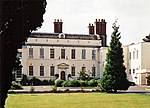Shifnal railway station
1849 establishments in EnglandDfT Category F2 stationsFormer Great Western Railway stationsRailway stations in Great Britain opened in 1849Railway stations in Shropshire ... and 6 more
Railway stations served by Transport for Wales RailRailway stations served by West Midlands TrainsShifnalShropshire building and structure stubsUse British English from February 2017West Midlands (region) railway station stubs

Shifnal railway station is a railway station which serves the town of Shifnal in Shropshire, England. The station is managed by West Midlands Trains, who provide the majority of services that call here (it is also served by Transport for Wales, primarily on Sundays). The station (opened in 1849) is located on a viaduct/causeway high above the village itself. It is on the Shrewsbury to Wolverhampton Line. When Shifnal was controlled by semaphore signalling it boasted a three-storey signal box. The building by the entrance at street level is not in railway use and there are no permanent buildings left at platform level.
Excerpt from the Wikipedia article Shifnal railway station (License: CC BY-SA 3.0, Authors, Images).Shifnal railway station
Geographical coordinates (GPS) Address Nearby Places Show on map
Geographical coordinates (GPS)
| Latitude | Longitude |
|---|---|
| N 52.666 ° | E -2.372 ° |
Address
TF11 9AP
England, United Kingdom
Open on Google Maps






